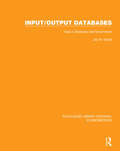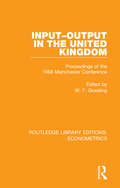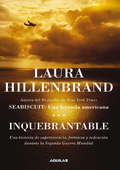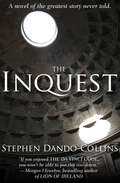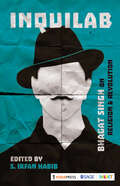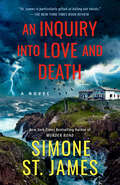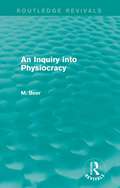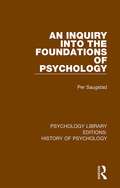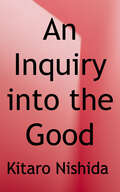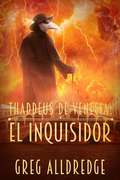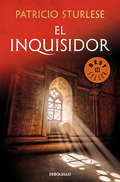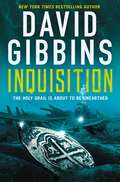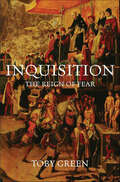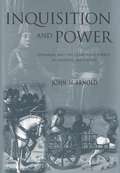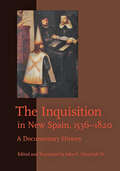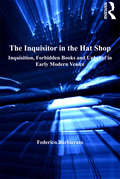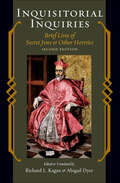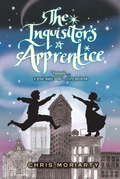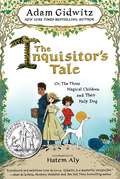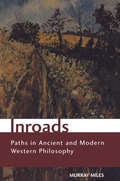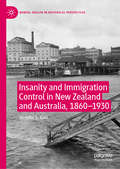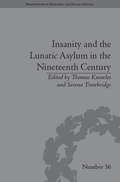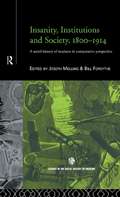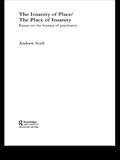- Table View
- List View
Input/Output Databases: Uses in Business and Government (Routledge Library Editions: Econometrics #7)
by Jay M. GouldOriginally published in 1979. An Input/output database is an information system carrying current data on the intermediate consumption of any product or service by all the specified major firms that consume it. This book begins with a survey of how the interrelationships of an economic system can be represented in a two-dimensional model which traces the output of each economic sector to all other sectors. It talks about how the use of such databases to identify major buyers and sellers can illuminate problems of economic policy at the national, regional, and corporate level and aid in analyzing factors affecting the control of inflation, energy use, transportation, and environmental pollution. The book discusses how advances in database technology, have brought to the fore such issues as the right to individual privacy, corporate secrecy, the public’s right of access to stored data, and the use of such information for national planning in a free-enterprise society.
Input-Output in the United Kingdom: Proceedings of the 1968 Manchester Conference (Routledge Library Editions: Econometrics #5)
by W. F. GosslingOriginally published in 1970. Input-output analysis has been described as the "lynch-pin of modern economic planning". Its purpose is to trace the consequences of any economic change through each sector of the economy; to measure, for example, the effects of an increase in fuel tax on the price of food, or of an expansion in car production on the country’s import bill. This kind of knowledge is clearly essential for making economic predictions. This book presents the proceedings of the 1968 Manchester Conference including six outline papers, each followed by discussion, and several summaries of ongoing and proposed research which were added afterwards. The speakers and participants constituted a representative sample of persons from Industry and Commerce, as well as the Universities and the Civil Service.
Inquebrantable
by Laura HillenbrandRetrato de la extraordinaria historia de Louie Zamperini, un atleta olímpico que se convirtió en aviador de la Segunda Guerra Mundial, en náufrago y en prisionero japonés. Inquebrantable fue adaptada en 2014 por Angelina Jolie, película que tuvo 3 nominaciones a los premios Oscar y fue incluida por el American Film Institute en el Top 10 de las mejores películas del año. Una historia de supervivencia, valor y resistencia durante la Segunda Guerra Mundial. Louie Zamperini, niño problemático, atleta olímpico, aviador durante la Segunda Guerra Mundial, náufrago en el Pacífico Sur, prisionero de los japoneses... un superviviente. Junio, 1943. Louie Zamperini, bombardero de la Segunda Guerra Mundial y atleta olímpico, se encuentra tendido sobre una pequeña balsa a la deriva en la inmensidad del océano Pacífico. Junto a él yacen otros dos compañeros. Sus cuerpos están abrasados por el sol y un grupo de tiburones los acecha cada minuto. Llevan 27 días sin rumbo y hace mucho que perdieron la esperanza de ser rescatados. Un sonido metálico los alerta... es un avión -pueden ver su destello a lo lejos-, Zamperini arroja dos bengalas. Los náufragos se desesperan, pero de pronto lo ven reaparecer. La tripulación los ha visto. El avión empieza a descender y los hombres se percatan con espanto de que se trata de un bombardero japonés y de que ellos son su objetivo. No hay salida. Así comienza Inquebrantable, una de las historias reales más impactantes de la Segunda Guerra Mundial. Laura Hillenbrand, autora de Seabiscuit, articula con la destreza de las grandes novelistas la vida de un hombre extraordinario que tuvo una infancia complicada, que descubrió que poseía un increíble don para correr que lo llevó a participar en los Juegos Olímpicos de Berlín y que se convirtió en aviador durante la guerra, una experiencia dramática que lo puso al límite envarias ocasiones. Una obra imprescindible cuya lectura atrapa desde las primeras páginas, una historia de supervivencia, valor y resistencia que no dejará indiferente a nadie. Una odisea contemporánea.
The Inquest: A Novel of the Greatest Story Never Told
by Stephen Dando-CollinsIn the time of Vespasian, just after Rome has crushed the Jewish Revolt, Julius Varro, a Roman Questor (an investigating magistrate )is commissioned to investigate the story that a Jew rose from the dead after being crucified in Jerusalem. Because the fast-growing Nazarene sect founded by the martyr's followers is becoming a threat to the stability of the region, there is much riding on debunking the story. Questor Varro has to deal with the evidence that goes back forty years, with most witnesses long dead and the living ones lying to protect themselves. But he is intent on producing a report that will demolish the claims of these religious fanatics. His investigation stirs intrigue, religious passion, and violence, to say nothing of an attraction to a beautiful Jewish slave girl. Questor Varro's report methodically destroys the myth fueling the newborn Christian movement. But then an extraordinary event occurs that changes everything.
Inquilab: Bhagat Singh on Religion & Revolution
by S Irfan HabibExtolled for his extraordinary courage and sacrifice, Bhagat Singh is one of our most venerated freedom fighters. He is valourised for his martyrdom, and rightly so, but in the ensuing enthusiasm, most of us forget, or consciously ignore, his contributions as an intellectual and a thinker. He not only sacrificed his life, like many others did before and after him, but he also had a vision of independent India. In the current political climate, when it has become routine to appropriate Bhagat Singh as a nationalist icon, not much is known or spoken about his nationalist vision. Inquilab: Bhagat Singh on Religion and Revolution provides a corrective to such a situation by bringing together some of Bhagat Singh′s seminal writings on his pluralist and egalitarian vision. In doing so, it compels the reader to see that while continuing to celebrate the memory of Bhagat Singh as a martyr and a nationalist, we must also learn about his intellectual legacy. This important book also makes a majority of these writings, hitherto only available in Hindi, accessible for the first time to the English-language readership.
An Inquiry Into Love and Death
by Simone St. JamesIn 1920's England, a young woman searches for the truth behind her uncle's mysterious death in a town haunted by a restless ghost... Oxford student Jillian Leigh works day and night to keep up with her studies--so to leave at the beginning of the term is next to impossible. But after her uncle Toby, a renowned ghost hunter, is killed in a fall off a cliff, she must drive to the seaside village of Rothewell to pack up his belongings. Almost immediately, unsettling incidents--a book left in a cold stove, a gate swinging open on its own--escalate into terrifying events that convince Jillian an angry spirit is trying to enter the house. Is it Walking John, the two-hundred-year-old ghost who haunts Blood Moon Bay? And who beside the ghost is roaming the local woods at night? If Toby uncovered something sinister, was his death no accident? The arrival of handsome Scotland Yard inspector Drew Merriken, a former RAF pilot with mysteries of his own, leaves Jillian with more questions than answers--and with the added complication of a powerful, mutual attraction. Even as she suspects someone will do anything to hide the truth, she begins to discover spine-chilling secrets that lie deep within Rothewell...and at the very heart of who she is.
An Inquiry into Physiocracy (Routledge Revivals)
by Max BeerThe common understanding of physiocracy – the school of eighteenth-century political economy associated with thinkers such as Boisguillebert and Quesnay – is often confined to the view that it considered agriculture the only source of wealth, and manufacture, trade and export as unproductive. The limitations of this view are particularly acute for those wishing to chart the ancien régime as it approached 1789. First published in 1939, this study attempts to answer such questions as: What is the meaning of physiocracy? What is the provenance of its various doctrines? What were its ultimate intentions? For many it is unclear how the physiocrats could expound such views against all the arguments employed by their opponents: particularly so given that, among them, were men revered by the likes of Adam Smith, either as profound thinkers, such as Quesnay, or as statesmen, such as Turgot.
An Inquiry into the Foundations of Psychology (Psychology Library Editions: History of Psychology)
by Per SaugstadDr Saugstad’s dominant interest was in the area of thinking. Many psychologists would have been familiar with his published work in this field at the time. To gain a clearer understanding of the thought processes, he carried out extensive studies of perception. First published in 1965, this book originated in an attempt to reconcile a phenomenological and a behavioristic approach to psychology. Basic assumptions in phenomenology, behavioristics and psychophysics are examined. It is shown that in phenomenology theoretical concepts tend to be treated as observations, whereas in behavioristics observations tend to be treated as theoretical concepts. It is pointed out that the relationship between observer and observed event is confused throughout the history of psychology. This confusion, the author insists, is due to the fact that man’s cognitive processes are to a large extent unknown. In relating observations to each other, the psychologist will of necessity contaminate his observations unless he follows specific rules. This fundamental point had apparently not been previously realized by psychologists. In order to develop an adequate conception of scientific psychology, the nature of man’s cognitive processes must be taken into account. When this is done, one sees that drastic revisions of current conceptions of psychology are necessary. This book presents a conception of psychology which does take into account man’s cognitive processes.
An Inquiry into the Good
by Kitaro NishidaThis book represented the foundation of Nishida's philosophy--reflecting both his deep study of Zen Buddhism and his thorough analysis of Western philosophy--and established its author as the foremost Japanese philosopher of this century. <p><p>In this important new translation, two scholars--one Japanese and one American--have worked together to present a lucid and accurate rendition of Nishida's ideas.
El Inquisidor (Thaddeus de Venecia #1)
by Greg AlldredgeSólo intérpretes en un escenario. Thaddeus había logrado abrirse camino hasta la cima de su profesión. Como inquisidor del Dux, disfrutaba de todas las comodidades que ofrecía la Venecia de clase media. Todo ello, hasta que le es asignado un llorón escriba de Padua, Geovanni. Desde entonces su vida da un giro hacia lo incierto. Siéndoles encomendada la tarea imposible de descubrir el origen de una extraña epidemia, el inquisidor y el escriba son desterrados de Venecia hasta que encuentren una solución. Extraños elementos acechan en la zona, y no son los turcos. La primera tarea de ambos funcionarios es llegar intactos a la ciudad de Udine, asolada por la peste. ¿Serán capaces de encontrar la fuente y regresar? ¿Sobrevivirán? Lee el primer libro El Inquisidor, de la trilogía Thaddeus de Venecia, para averiguarlo.
El inquisidor
by Patricio SturleseUn thriller trepidante ambientado en el turbulento final del siglo XVI. Un libro sagrado, prohibidoy que puede hacer cimbrar los cimientos de la Iglesia. 1597, aposentos de Clemente VIII, en el Vaticano. Angelo DeGrasso, Inquisidor General de Liguria, es recibido en audiencia privada por el Papa, el Superior General de la Inquisición y un extraño astrólogo llamado Darko. Le acaban de comunicar que un hereje llamado Eros Gianmaria, que ha sido trasladado desde Venecia, guarda aún un terrible secreto: es el único que conoce el paradero de la última copia de un libro prohibido, el Necronomicón, y Angelo ha de usar su pericia para conseguir una confesión. Pero no dispondrá de mucho tiempo para hacerlo, pues en pocos días ha de partir hacia el Nuevo Mundo en una misión que no le será comunicada hasta que noesté embarcado. Al descender la escalera de la basílica de San Pedro, en un frío día de otoño, Angelo presiente que su vida va a dar un giro. El implacable Inquisidor General de Liguria no tardará mucho en descubrir que ni siquiera él es lo que parece... Una novela apasionante que nos transporta al turbulento final del siglo XVI, en el que la Iglesia Católica mata por defender la ortodoxia y conservar su poder; en el que los aquelarres pueblan los bosques italianos bajo la protección de Satán y de la Luna; en el que todos están dispuestos a morir por su fe, pero ¿qué fe?
Inquisition (Jack Howard #10)
by David GibbinsThe latest Jack Howard thriller from internationally bestselling mastermind David Gibbins.258As the blood of martyred Christians runs through Rome's catacombs, Pope Sixtus entrusts their most sacred object to a devoted follower. Soon after, the Holy Grail disappears into the darkness of time.1684 While overseeing the evacuation of the English colony of Tangier, Samuel Pepys attempts to retrieve a treasure which has resurfaced after more than a thousand years. Meanwhile, a Jewish merchant is tortured by the Altamanus, a secret group determined to locate the Grail.Present DayA wreck off the Cornish coast reveals clues to a mystery that marine archaeologist Jack Howard had thought beyond solving. He embarks on an epic quest that takes him to the sunken ruins of the pirate city of Port Royal in Jamaica. But the specter of the deadly Inquisition dogs his every step, and Jack must face a descent into hell itself if he is to uncover the greatest reward in Christendom.Gibbins, who has led numerous underwater archeology expeditions around the world, writes with an authority that makes “the astounding seem more than plausible” (Parmenion Books). This latest Jack Howard novel brings together historical details and a thrilling plot for an action-packed adventure.
Inquisition: The Reign of Fear
by Toby GreenA journey across centuries of religious conflict Toby Green's incredible new book brings a vast panorama to life by focusing on the untold stories of individuals from all walks of life and every section of society who were affected by the Inquisition. From witches in Mexico, bigamists in Brazil, Freemasons, Hindus, Jews, Moslems and Protestants, the Inquisition reached every aspect of society. This history, though filled with stories of terror and the unspeakable ways in which human beings can treat one another, is ultimately one of hope, underscoring the resilience of the human spirit. Stretching from the unification of Spain under Ferdinand and Isabella in the fifteenth century to the Napoleanic wars, The Inquisition details this incredible history in all its richness and complexity.
Inquisition and Power
by John H. ArnoldWhat should historians do with the words of the dead? Inquisition and Power reformulates the historiography of heresy and the inquisition by focusing on depositions taken from the Cathars, a religious sect that opposed the Catholic church and took root in southern France during the twelfth century. Despite the fact that these depositions were spoken in the vernacular, but recorded in Latin in the third person and rewritten in the past tense, historians have often taken these accounts as verbatim transcriptions of personal testimony. This belief has prompted some historians, including E. Le Roy Ladurie, to go so far as to retranslate the testimonies into the first-person. These testimonies have been a long source of controversy for historians and scholars of the Middle Ages.Arnold enters current theoretical debates about subjectivity and the nature of power to develop reading strategies that will permit a more nuanced reinterpretation of these documents of interrogation. Rather than seeking to recover the true voice of the Cathars from behind the inquisitor's framework, this book shows how the historian is better served by analyzing texts as sites of competing discourses that construct and position a variety of subjectivities. In this critically informed history, Arnold suggests that what we do with the voices of history in fact has as much to do with ourselves as with those we seek to 'rescue' from the silences of past.
The Inquisition in New Spain, 1536–1820: A Documentary History
by John F. Chuchiak IVThe Inquisition! Just the word itself evokes, to the modern reader, endless images of torment, violence, corruption, and intolerance committed in the name of Catholic orthodoxy and societal conformity. But what do most people actually know about the Inquisition, its ministers, its procedures? This systematic, comprehensive look at one of the most important Inquisition tribunals in the New World reveals a surprisingly diverse panorama of actors, events, and ideas that came into contact and conflict in the central arena of religious faith.Edited and annotated by John F. Chuchiak IV, this collection of previously untranslated and unpublished documents from the Holy Office of the Inquisition in New Spain provides a clear understanding of how the Inquisition originated, evolved, and functioned in the colonial Spanish territories of Mexico and northern Central America. The three sections of documents lay out the laws and regulations of the Inquisition, follow examples of its day-to-day operations and procedures, and detail select trial proceedings. Chuchiak’s opening chapter and brief section introductions provide the social, historical, political, and religious background necessary to comprehend the complex and generally misunderstood institutions of the Inquisition and the effect it has had on societal development in modern-day Mexico, Guatemala, El Salvador, Nicaragua, and Honduras. Featuring fifty-eight newly translated documents, meticulous annotations, and trenchant contextual analysis, this documentary history is an indispensable resource for anyone seeking to understand the Inquisition in general and its nearly three-hundred-year reign in the New World in particular.
The Inquisitor in the Hat Shop: Inquisition, Forbidden Books and Unbelief in Early Modern Venice
by Federico BarbieratoEarly modern Venice was an exceptional city. Located at the intersection of trade routes and cultural borders, it teemed with visitors, traders, refugees and intellectuals. It is perhaps unsurprising, then, that such a city should foster groups and individuals of unorthodox beliefs, whose views and life styles would bring them into conflict with the secular and religious authorities. Drawing on a vast store of primary sources - particularly those of the Inquisition - this book recreates the social fabric of Venice between 1640 and 1740. It brings back to life a wealth of minor figures who inhabited the city, and fostered ideas of dissent, unbelief and atheism in the teeth of the Counter-Reformation. The book vividly paints a scene filled with craftsmen, friars and priests, booksellers, apothecaries and barbers, bustling about the city spaces of sociability, between coffee-houses and workshops, apothecaries' and barbers' shops, from the pulpit and drawing rooms, or simply publicly speaking about their ideas. To give depth to the cases identified, the author overlays a number of contextual themes, such as the survival of Protestant (or crypto-Protestant) doctrines, the political situation at any given time, and the networks of dissenting groups that flourished within the city, such as the 'free metaphysicists' who gathered in the premises of the hatter Bortolo Zorzi. In so doing this rich and thought provoking book provides a systematic overview of how Venetian ecclesiastical institutions dealt with the sheer diffusion of heterodox and atheistical ideas at different social levels. It will be of interest not only to scholars of Venice, but all those with an interest in the intellectual, cultural and religious history of early-modern Europe.
Inquisitorial Inquiries: Brief Lives of Secret Jews and Other Heretics
by Richard L. Kagan Abigail DyerOn the first day of Francisco de San Antonio's trial before the Spanish Inquisition in Toledo in 1625, his interrogators asked him about his parentage. His real name, he stated, was Abram Rubén, and he had been born in Fez of Jewish parents. How then, Inquisitors wanted to know, had he become a Christian convert? Why had a Hebrew alphabet been found in his possession? And what was his business at the Court in Madrid? "He was asked," according to his dossier, "for the story of his life." His response, more than ten folios long, is one of the many involuntary autobiographies created by the logic of the Inquisition that today provide rich insights into both the personal lives of the persecuted and the social, cultural, and political realities of the age.In the first edition of Inquisitorial Inquiries, Richard L. Kagan and Abigail Dyer collected, translated, and annotated six of these autobiographies from a diverse group of prisoners. Now they add the fascinating life story of another victim of the Inquisition: Esteban Jamete, a French sculptor accused of being a Protestant. Each of the autobiographies has been selected to represent a particular political or social issue, while at the same time raising more intimate questions about the religious, sexual, political, or national identities of the prisoners. Among them are a politically incendiary prophet, a self-proclaimed hermaphrodite, and a morisco, an Islamic convert to Catholicism.
The Inquisitor's Apprentice
by Chris Moriarty Mark Edward GeyerThe day Sacha found out he could see witches was the worst day of his life . . . Being an Inquisitor is no job for a nice Jewish boy. But when the police learn that Sacha Kessler can see witches, he's apprenticed to the department's star Inquisitor, Maximillian Wolf. Their mission is to stop magical crime. And New York at the beginning of the twentieth century is a magical melting pot where each ethnic group has its own brand of homegrown witchcraft, and magical gangs rule the streets from Hell's Kitchen to Chinatown. Soon Sacha has teamed up with fellow apprentice Lily Astral, daughter of one of the city's richest Wall Street Wizards--and a spoiled snob, if you ask Sacha. Their first case is to find out who's trying to kill Thomas Edison. Edison has invented a mechanical witch detector that could unleash the worst witch-hunt in American history. Every magician in town has a motive to kill him. But as the investigation unfolds, all the clues lead back to the Lower East Side. And Sacha soon realizes that his own family could be accused of murder!
The Inquisitor's Tale: Or, The Three Magical Children and Their Holy Dog (Newbery Honor Ser.)
by Adam Gidwitz Hatem AlyOn a dark night, travelers from across France cross paths at an inn and begin to tell stories of three children. Their adventures take them on a chase through France: they are taken captive by knights, sit alongside a king, and save the land from a farting dragon.<P><P> On the run to escape prejudice and persecution and save precious and holy texts from being burned, their quest drives them forward to a final showdown at Mont Saint-Michel, where all will come to question if these children can perform the miracles of saints. Join William, an oblate on a mission from his monastery; Jacob, a Jewish boy who has fled his burning village; and Jeanne, a peasant girl who hides her prophetic visions. They are accompanied by Jeanne's loyal greyhound, Gwenforte... recently brought back from the dead. <P> In a style reminiscent of The Canterbury Tales, our narrator collects their stories and the saga of these three unlikely allies begins to come together. Beloved bestselling author Adam Gidwitz makes his long awaited return with his first new world since his hilarious and critically acclaimed Grimm series.<P> <b>Winner of Newbery Honor</b>
Inroads
by Murray MilesThis unique introduction to philosophy is designed as a companion volume to a number of classic philosophical texts widely used in first- and upper-year philosophy courses. While remaining clear and readable, Inroads provides detailed analyses of fundamental issues in metaphysics and morals: the existence of God, the meaning of death, and the elements and definitions of the 'good life' for humankind.Combining a historical with a systematic approach, Murray Miles's work straddles the customary divisions between ancient and modern, and Anglo-American and continental European philosophy. In each of its five main parts - in turn, focusing on Socrates, Plato, Descartes, Hume, and Sartre - Inroads discusses, from a philosophical rather than a religious or scientific perspective, those questions that make up the common inheritance of academic philosophy and ethico-religious thought. Other features include a detailed glossary of philosophical terms, suggestions for further reading, and questions for reflection and review. Inroads is a useful text for first-year undergraduate courses or, equally, a sound resource for the general reader looking for a good grounding in philosophy and its history.
Insanity and Immigration Control in New Zealand and Australia, 1860–1930 (Mental Health in Historical Perspective)
by Jennifer S. KainThis book examines the policy and practice of the insanity clauses within the immigration controls of New Zealand and the Commonwealth of Australia. It reveals those charged with operating the legislation to be non-psychiatric gatekeepers who struggled to match its intent. Regardless of the evolution in language and the location at which a migrant’s mental suitability was assessed, those with ‘inherent mental defects’ and ‘transient insanity’ gained access to these regions. This book accounts for the increased attempts to medicalise border control in response to the widening scope of terminology used for mental illnesses, disabilities and dysfunctions. Such attempts co-existed with the promotion of these regions as ‘invalids’ paradises’ by governments, shipping companies, and non-asylum doctors. Using a bureaucratic lens, this book exposes these paradoxes, and the failings within these nineteenth- and early twentieth-century Australasian nation-state building exercises.
Insanity and Sanctity in Byzantium
by Youval RotmanIn the Roman and Byzantine Near East, the holy fool emerged in Christianity as a way of describing individuals whose apparent madness allowed them to achieve a higher level of spirituality. Youval Rotman examines how the figure of the mad saint or mystic was used as a means of individual and collective transformation prior to the rise is Islam.
Insanity and the Lunatic Asylum in the Nineteenth Century (Perspectives in Economic and Social History #36)
by Serena TrowbridgeThe nineteenth-century asylum was the scene of both terrible abuses and significant advancements in treatment and care. The essays in this collection look at the asylum from the perspective of the place itself – its architecture, funding and purpose – and at the experience of those who were sent there.
Insanity, Institutions and Society, 1800-1914 (Routledge Studies in the Social History of Medicine)
by Joseph Melling Bill ForsytheThis comprehensive collection provides a fascinating summary of the debates on the growth of institutional care during the nineteenth and twentieth centuries. Revising and revisiting Foucault, it looks at the significance of ethnicity, race and gender as well as the impact of political and cultural factors, throughout Britain and in a colonial context. It questions historically what it means to be mad and how, if at all, to care.
The Insanity of Place / The Place of Insanity: Essays on the History of Psychiatry (Routledge Studies in Cultural History)
by Andrew ScullThis compelling book brings together many of the major papers published by Andrew Scull in the history of psychiatry over the past decade and a half. Examining some of the major substantive debates in the field from the eighteenth century to the present, the historiographic essays provide a critical perspective on such major figures as Michel Foucault, Roy Porter and Edward Shorter. Chapters on psychiatric therapeutics and on the shifting social responses to madness over a period of almost three centuries add to a comprehensive assessment of Anglo-American confrontations with madness in this period, and make the book invaluable for those concerned to understand the psychiatric enterprise. The Insanity of Place/The Place of Insanity will be of interest to students and professionals of the history of medicine and of psychiatry, as well as sociologists concerned with deviance and social control, the sociology of mental illness and the sociology of the professions.
